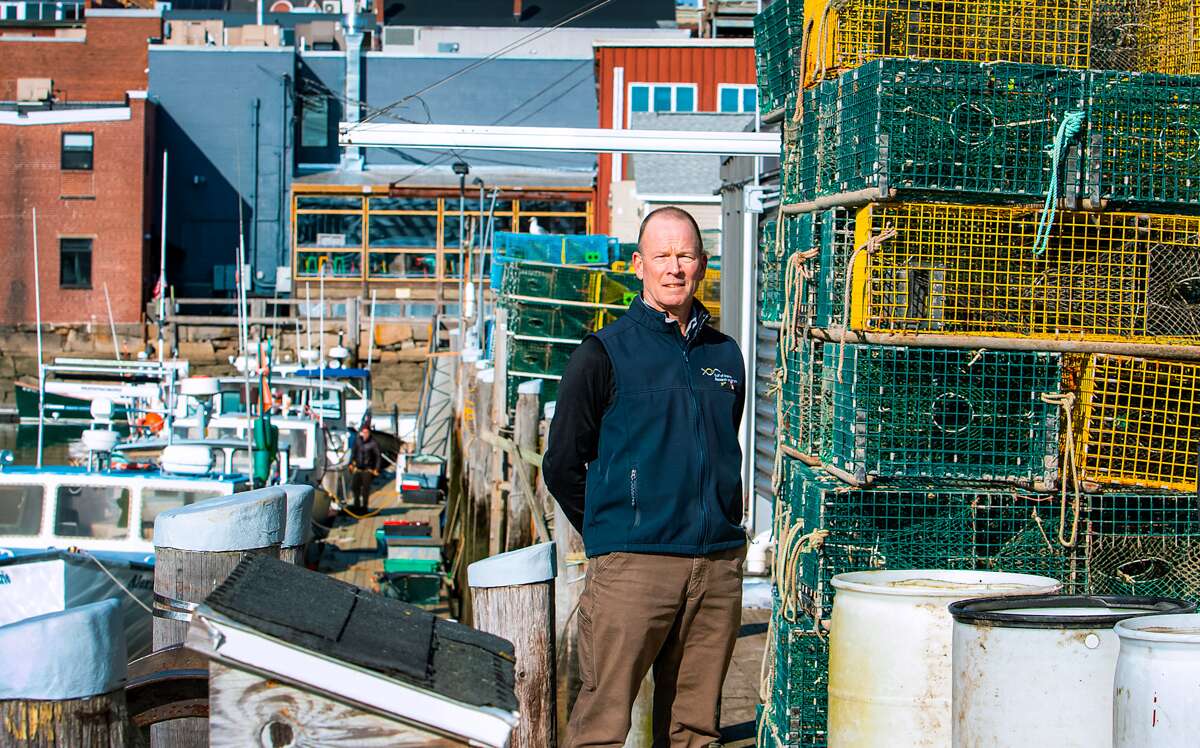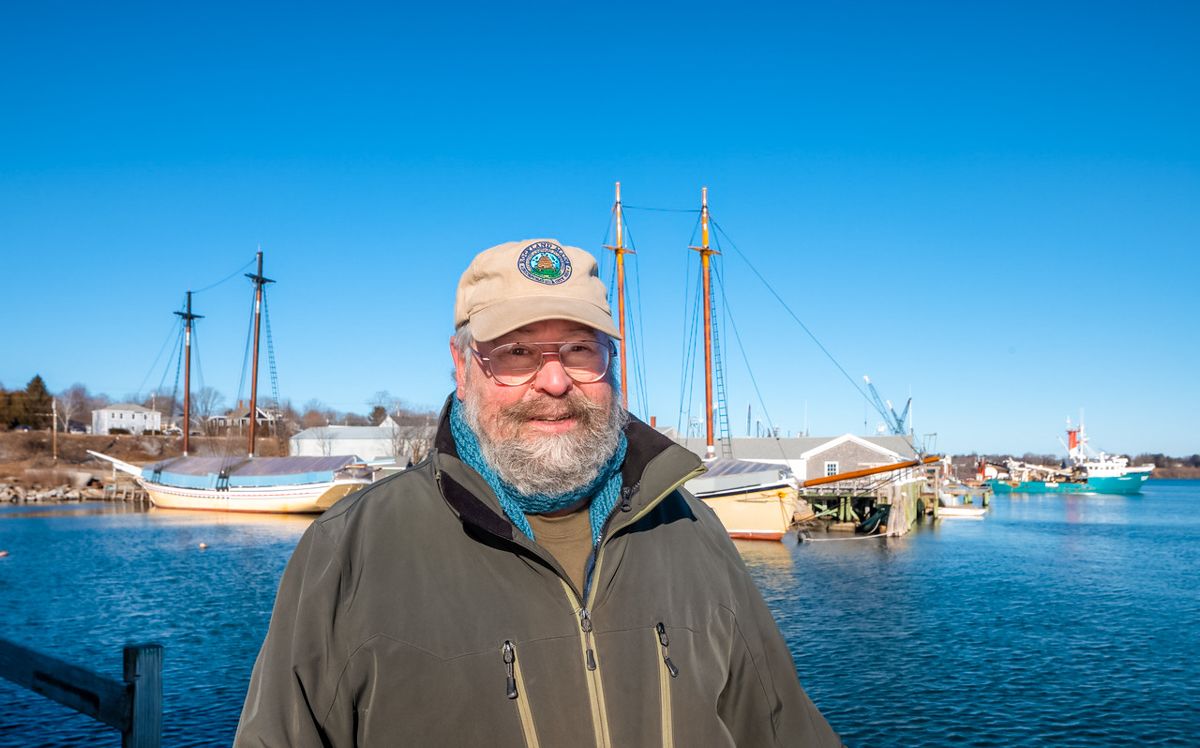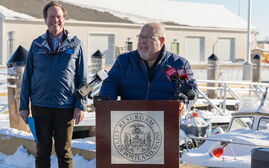
Processing Your Payment
Please do not leave this page until complete. This can take a few moments.
- News
-
Editions
View Digital Editions
Biweekly Issues
- December 1, 2025
- Nov. 17, 2025
- November 03, 2025
- October 20, 2025
- October 6, 2025
- September 22, 2025
- + More
Special Editions
- Lists
- Viewpoints
-
Our Events
Event Info
Award Honorees
- Calendar
- Biz Marketplace
The ‘last 20 miles’: Real estate boom, new demands threaten Maine’s working waterfront
 Photo / Dave Clough
Ed Glaser, mayor of Rockland, on a parcel of working waterfront that is up for sale. He cites the need for new investment and growth.
Photo / Dave Clough
Ed Glaser, mayor of Rockland, on a parcel of working waterfront that is up for sale. He cites the need for new investment and growth.
Rockland has become a microcosm of the debate on how to protect and adapt Maine’s working waterfronts in the face of commercial development pressure and climate change.
The potential sale of three commercial waterfront properties has the potential to bring new development and tax revenue, but also great change to the town’s character.
The sale would package together properties that in total span 8.77 acres of land and waterfront infrastructure and include more than 55,000 square feet of industrial space nestled between the harbor and Main Street at the north end of the city’s downtown.
Current businesses include Schooner Wharf, which offers deep-water berthing for ships, Steel-Pro Inc., which manufactures stainless steel tanks and other industrial items, and North End Shipyard Inc., a marina and boatyard that services much of Maine’s tall ship fleet.
The properties are being marketed as development opportunities for hotels, restaurants, retail or office space, residential or marine usage and are listed for sale for $13.9 million, according to the New England Commercial Property Exchange.
“We expect that whatever we do will be controversial,” says Ed Glaser, mayor of Rockland. “We will try to find balance. We want new investment in Rockland somehow. Growth — it’s essential. You can’t stay still or stay in the past. Growth can be controlled or funneled into where it makes the most sense.”
What’s left
Elsewhere in Rockland, the nonprofit Island Institute has been sounding the alarm about shrinking coastal frontage still available for commercial use by fishermen, boatbuilders, marinas and so on.
Of Maine’s 5,300 miles of coastline, just a fraction, 20 miles, is still available for working waterfront, according to the nonprofit’s 2014 report, “The Last 20 Miles.”
Another study, by the Maine State Planning Office, suggests that the majority of Maine’s coastline will be classified as suburban or urban by 2050.
The question of how to balance growth and protect working waterfronts is playing out across the state.
In Portland, Union Wharf recently sold for $12.35 million to the Gulf of Maine Research Institute and the Custom House Wharf has a deal pending to a Maine group that plans to keep it as a piece of working waterfront.
“There’s insidious issues playing out in the coastal marketplace,” Don Perkins, president and CEO of the Gulf of Maine Research Institute. “There will be increasing pressure on the waterfront. The valuation of Portland’s working waterfront will increase. The price is only headed in one direction.”
GMRI first got connected to the Union Wharf when a leader in the fishing community came to the nonprofit in February 2021 to alert them that the historic 1793 wharf would change hands from the Poole family.
GMRI already owned Wright’s Wharf, a neighbor to Union Wharf.
“We understand what a working wharf is, what it takes to build on sediment before you get to bedrock. We understand the wear and tear,” Perkins says.

After studying Union Wharf and talking to people in the community and on the harbor, Perkins says he realized no one else in the maritime industry was going to buy it. One prospective buyer from New York “was a caricature of who you’d rather not see take control of the waterfront,” Perkins says.
“Union Wharf is the centerpiece of the Portland waterfront. It’s the firewall between tourism development on the Eastern waterfront and the working waterfront,” Perkins says. “It’s really critical to protect it. The hope is that what we’ve done will cause people to think of other options to protect it.”
“Access to the waterfront is a finite resource that’s always under real estate pressure. We can’t create more once it’s gone,” Perkins says.
Union Wharf was profitable with 17 building tenants and vessel tenants, on a diversified working waterfront real estate business, Perkins says.
The nonprofit put together a mortgage for 80% of the $12.35 million transaction price and raised 20% from friendly donors offering low interest rates.
“A lot of people lent their shoulder to making this complicated deal happen,” Perkins says.
Perkins says working waterfront interests need to balance growth of the aquaculture industry with the lobster industry. Then there are less visible but important uses such as tug boats, marine construction, salvage companies, he says.
“There’s a whole system of less visible but vital businesses that need working waterfront,” Perkins says.
“Fishing is always changing. The lobster industry quintupled from 1985 to 2015, going from 25 to 30 million pounds a year to over 100 million pounds a year. Ground fishing has gone the other way,” Perkins says. “We think there’s an emerging 21st century blue economy. If it doesn’t have wharf infrastructure and working waterfront, it won’t grow.”
Changes at a Yarmouth boatyard
In Yarmouth, at the old Even Keel Boatyard, local sea farmers, dock and boat builders, land use specialists, neighbors and Coastal Enterprises Inc. worked with the Sea Meadow Marine Foundation to acquire and protect 12 acres of working waterfront.
Sea Meadow, a nonprofit created to address the rapidly disappearing working waterfronts in Maine, closed on the property with a USDA Community Facilities loan from CEI and an operating grant from the Elmina B. Sewall Foundation.
The grant and loan funds will also help support a business incubator and marine business hub for early-stage fisheries and sustainable aquaculture businesses. There will also be space for marina services, the two preexisting boatbuilders and recreational use, including the Yarmouth Rowing Club. The current tenants support 26 working waterfront jobs.
“The working waterfront is a critical aspect of Maine’s economy and environmental health. If the working waterfront goes away, it’s not coming back,” says Chad Strater, Sea Meadow’s board president.
Biggest threats
Sam Belknap, senior community development officer of the Island Institute, says the biggest threats to working waterfront are commercial development pressures and climate change.
The Island Institute is a Rockland-based nonprofit that works to develop local economies and climate solutions for Maine’s island and coastal communities.
“It’s too big for any one organization to tackle,” says Belknap. “It has to come from across the state right on down to grassroots.”
Some communities, such as Vinalhaven, have strong working waterfront protections, while others don’t have zoning in place to offer protection, Belknap says.
“Code enforcement may sound boring, but it’s a huge tool in protecting working waterfronts. There are communities that understand it intimately and some — not yet. Small towns have mounting challenges on them and conflicting pressures,” Belknap says. “It’s up to communities to decide for themselves the balance between commercial uses and noncommercial uses for working waterfronts.”
William Needelman, waterfront coordinator for the city of Portland, sees zoning as a key tool to protect working waterfront from development.
“Zoning is the primary tool. It’s not always the best or only tool, but it’s effective,” Needelman says.
In Portland, housing construction is not allowed on certain waterfront areas. Hotels are not allowed.
“That takes away the speculative development,” Needelman says.
Portland has found that some uses are more compatible with working waterfronts, such as upper floor offices. The working dock is the most critical to be kept as working waterfront, but having restaurants and retail at the end adjacent to Commercial Street can be successful, too, Needelman says.
“You can’t zone everyone into the Stone Age, though. The working waterfront needs revenue to maintain the property. At what point is that revenue a danger to putting the waterfront out of balance?” Needelman says. “If the revenue of a pier is so low that the pier will degrade to the point that access will disappear anyway, that’s bad.”
Needelman says Portland needs to look to the future, as well.
The waters around the piers and wharves need to be dredged. Climate change and sea level rise adaptations need to be made.
“A robust and healthy balance sheet is the best adaptive strategy to combat sea level rise. If the books don’t balance, how to you make an investment to protect the wharf going forward?” Needelman says.
Overall, the city’s planning and development has to find a middle ground.
“It’s about achieving balance and encouraging complementary and compatible uses. We want to care of tourists. But if tourism overwhelms the working waterfront use, then you’re out of balance,” Needelman says.
Portland at one point had the option of following the path of big commercial retail development like Baltimore’s Inner Harbor, Needelman says. But a 1987 waterfront referendum approved by two-thirds of Portland voters put a moratorium on nonmarine development.
The pendulum has swung back and forth a bit since then on development restrictions, he says. But going forward, Needelman says he expects “the pendulum will continue to swing in the direction of the ocean.”
Changing demands on the waterfront
Back in Rockland, “We have to look at the working waterfront and protect it, but this is at a time of a diminishing groundfishing industry. At some point, if there’s no industry to support, you have to ask what we’re doing it for. We’re seeing declines in the lobster industry. We lost the shrimp industry. We’ve got declines in herring. We’ve lost so many fishing industries. No one is going to be happy to see a fish packing plant on the water,” Glaser says.
“We want to be supporting fishing, but fishing itself is changing and new marine industries are growing,” Glaser says. “Maybe seaweed. Maybe more shipping by ocean. Windmills may take a role. We don’t know.”
Of the three parcels for sale on the Rockland waterfront, Glaser says “there’s always interest, but it’s not as serious as we’d like. They’re a lot of money. But we’re in good shape. We’re not at the mercy of any one developer. We’re open to people with ideas.”
Mainebiz web partners
Related Content
I'm sick and tired of hearing these exaggerated stories of how long Maines's coastline is. It's approx. 250 nautical miles for its SW extremity on Kittery to its NE counterpart in Eastport period. Granted, it also features a multitude of bays, coves, islands and peninsula's which when aggregated with the rhumb line measurement greatly enhance the total number. If any of the Canadian maritime provinces are to be measured in a similar manner, they make Maine's coastline appear rather modest. Better to expound on our natural beauty and quaintness than to flex our muscles as if we are somehow superior - we're not. As far as I'm concerned, the Maine coast has been nearly sold out and is in need of a no vacancy sign as regards real estate. Scant now are the quiet coves, bays and shorelines the common person can now openly traverse without legally trespassing. The present situation has everything to with human greed, money and poor municipal foresight and little to do with the common man's humble quest for waterfront access whether it be for business or leisure. Rockland like other coastal cities and towns is in the cross-hairs of over-zealous and speculative development and would do well to try as best to maintain a hybrid scheme of all interested parties so as to maintain local charm and character, for once it's gone, it's gone forever. Time will tell if this is even possible given the money and stakes involved.

The Giving Guide
The Giving Guide helps nonprofits have the opportunity to showcase and differentiate their organizations so that businesses better understand how they can contribute to a nonprofit’s mission and work.
Learn More
Work for ME
Work for ME is a workforce development tool to help Maine’s employers target Maine’s emerging workforce. Work for ME highlights each industry, its impact on Maine’s economy, the jobs available to entry-level workers, the training and education needed to get a career started.
Learn More
Groundbreaking Maine
Whether you’re a developer, financer, architect, or industry enthusiast, Groundbreaking Maine is crafted to be your go-to source for valuable insights in Maine’s real estate and construction community.
Learn more-
The Giving Guide
The Giving Guide helps nonprofits have the opportunity to showcase and differentiate their organizations so that businesses better understand how they can contribute to a nonprofit’s mission and work.
-
Work for ME
Work for ME is a workforce development tool to help Maine’s employers target Maine’s emerging workforce. Work for ME highlights each industry, its impact on Maine’s economy, the jobs available to entry-level workers, the training and education needed to get a career started.
-
Groundbreaking Maine
Whether you’re a developer, financer, architect, or industry enthusiast, Groundbreaking Maine is crafted to be your go-to source for valuable insights in Maine’s real estate and construction community.
ABOUT
NEW ENGLAND BUSINESS MEDIA SITES
No articles left
Get access now
In order to use this feature, we need some information from you. You can also login or register for a free account.
By clicking submit you are agreeing to our cookie usage and Privacy Policy
Already have an account? Login
Already have an account? Login
Want to create an account? Register
Get access now
In order to use this feature, we need some information from you. You can also login or register for a free account.
By clicking submit you are agreeing to our cookie usage and Privacy Policy
Already have an account? Login
Already have an account? Login
Want to create an account? Register











1 Comments